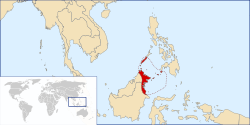Sultan of Sulu
| Sultanate of Sulu | |||||
| کسلطانن سولو دار الإسلام Kasultanan ng Sulu Kesultanan Sulu |
|||||
| Part of Bruneian Empire (1405–1578), Independent kingdom (1578–1851), Protectorate of Spain (1851–1898), Protectorate of the United States (1903–1915) | |||||
|
|||||
|
Map showing the extent of the Sultanate of Sulu in 1822 with borders of modern nation states
|
|||||
| Capital | |||||
| Languages | Arabic (de facto), Tausug, Bajau, Visayan, Banguingui and Malay | ||||
| Religion | Sunni Islam | ||||
| Government | Monarchy | ||||
| Sultan | |||||
| • | 1405–?? | Sharif ul-Hashim of Sulu (first) | |||
| • | 1974–1986 | Mohammed Mahakuttah Abdullah Kiram (last officially recognized) | |||
| History | |||||
| • | Ascension of Rajah Baginda | 17 November 1405 | |||
| • | Dissolution of Sultanate | 1915 | |||
| Currency | No official currency, the Barter system was used | ||||
| Today part of | |||||
The Sultanate of Sulu (Jawi: کسلطانن سولو دار الإسلام, Malay: Kesultanan Sulu, Filipino: Kasultanan ng Sulu, Arabic: سلطنة سولك) was a Muslim state that ruled the islands in the Sulu Archipelago, parts of Mindanao, certain portions of Palawan and north-eastern Borneo (present-day the certain parts of Sabah and North Kalimantan).
The sultanate was founded on 17 November 1405. by a Johore-born explorer and religious scholar Sharif ul-Hashim. Paduka Mahasari Maulana al Sultan Sharif ul-Hashim became his full regnal name, Sharif-ul Hashim is his abbreviated name. He settled in Buansa, Sulu. After the marriage of Abu Bakr and a local dayang-dayang (princess) Paramisuli, he founded the sultanate. The Sultanate gained its independence from the Bruneian Empire in 1578.
At its peak, it stretched over the islands that bordered the western peninsula of Mindanao in the east to Palawan in the north. It also covers the area in northeastern side of Borneo, stretching from Marudu Bay, to Tepian Durian (in present-day Kalimantan). While another source stated the area stretching from Kimanis Bay which also overlaps with the boundaries of the Bruneian Sultanate. Due to the arrival of western powers such as the Spanish, British, Dutch, French, German and American, the Sultan thalassocracy and sovereign political powers were relinquished by 1915 through an agreement that was signed with the last colonialist, the United States. In 1962, Philippine Government under the leadership of President Diosdado Macapagal officially recognised the continued existence of the Sultanate of Sulu. On 24 May 1974, Sultan Mohammad Mahakuttah Kiram (reigned 1974–1986), was the last officially recognized Sulu Sultan in the Philippines, having been recognized by President Ferdinand Marcos.
...
Wikipedia


